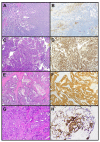New Pathological and Clinical Insights in Endometrial Cancer in View of the Updated ESGO/ESTRO/ESP Guidelines
- PMID: 34073635
- PMCID: PMC8198052
- DOI: 10.3390/cancers13112623
New Pathological and Clinical Insights in Endometrial Cancer in View of the Updated ESGO/ESTRO/ESP Guidelines
Abstract
Endometrial carcinoma represents the most common gynecological cancer in Europe and the USA. Histopathological classification based on tumor morphology and tumor grade has played a crucial role in the management of endometrial carcinoma, allowing a prognostic stratification into distinct risk categories, and guiding surgical and adjuvant therapy. In 2013, The Cancer Genome Atlas (TCGA) Research Network reported a large scale molecular analysis of 373 endometrial carcinomas which demonstrated four categories with distinct clinical, pathologic, and molecular features: POLE/ultramutated (7% of cases) microsatellite instability (MSI)/hypermutated (28%), copy-number low/endometrioid (39%), and copy-number high/serous-like (26%). In the present article, we report a detailed histological and molecular review of all endometrial carcinoma histotypes in light of the current ESGO/ESTRO/ESP guidelines. In particular, we focus on the distribution and prognostic value of the TCGA groups in each histotype.
Keywords: CTNNB1; TCGA; clear cell carcinoma; endometrial carcinoma; prognosis; serous carcinoma; undifferentiated carcinoma.
Conflict of interest statement
The authors declare no conflict of interest.
Figures


Similar articles
-
TCGA Molecular Prognostic Groups of Endometrial Carcinoma: Current Knowledge and Future Perspectives.Int J Mol Sci. 2022 Oct 2;23(19):11684. doi: 10.3390/ijms231911684. Int J Mol Sci. 2022. PMID: 36232987 Free PMC article. Review.
-
Impact of endometrial carcinoma histotype on the prognostic value of the TCGA molecular subgroups.Arch Gynecol Obstet. 2020 Jun;301(6):1355-1363. doi: 10.1007/s00404-020-05542-1. Epub 2020 Apr 15. Arch Gynecol Obstet. 2020. PMID: 32296930
-
Endometrial carcinoma: 10 years of TCGA (the cancer genome atlas): A critical reappraisal with comments on FIGO 2023 staging.Gynecol Oncol. 2024 Jul;186:94-103. doi: 10.1016/j.ygyno.2024.04.008. Epub 2024 Apr 13. Gynecol Oncol. 2024. PMID: 38615479 Review.
-
High-grade endometrial carcinomas: Morphologic spectrum and molecular classification.Semin Diagn Pathol. 2022 May;39(3):176-186. doi: 10.1053/j.semdp.2021.11.002. Epub 2021 Nov 20. Semin Diagn Pathol. 2022. PMID: 34852949 Review.
-
Molecular Genetics of Endometrial Carcinoma.Annu Rev Pathol. 2019 Jan 24;14:339-367. doi: 10.1146/annurev-pathol-020117-043609. Epub 2018 Oct 17. Annu Rev Pathol. 2019. PMID: 30332563 Review.
Cited by
-
TCGA Molecular Prognostic Groups of Endometrial Carcinoma: Current Knowledge and Future Perspectives.Int J Mol Sci. 2022 Oct 2;23(19):11684. doi: 10.3390/ijms231911684. Int J Mol Sci. 2022. PMID: 36232987 Free PMC article. Review.
-
What Role do Androgens Play in Endometrial Cancer?J Pers Med. 2023 Feb 16;13(2):341. doi: 10.3390/jpm13020341. J Pers Med. 2023. PMID: 36836575 Free PMC article. Review.
-
Corded and hyalinized endometrioid endometrial carcinoma with high-grade features: a clinicopathological and TCGA-based molecular analysis.Virchows Arch. 2023 Apr;482(4):671-678. doi: 10.1007/s00428-022-03472-8. Epub 2022 Dec 23. Virchows Arch. 2023. PMID: 36550216
-
Liquid Biopsy for Monitoring EC Patients: Towards Personalized Treatment.Cancers (Basel). 2022 Mar 9;14(6):1405. doi: 10.3390/cancers14061405. Cancers (Basel). 2022. PMID: 35326558 Free PMC article. Review.
-
Association of Lymphovascular Space Invasion (LVSI) with Histological Tumor Grade and Myometrial Invasion in Endometrial Carcinoma: A Review Study.Adv Biomed Res. 2023 Jun 28;12:159. doi: 10.4103/abr.abr_52_23. eCollection 2023. Adv Biomed Res. 2023. PMID: 37564444 Free PMC article. Review.
References
Publication types
LinkOut - more resources
Full Text Sources
Miscellaneous

